ContractNerd: An AI Tool to Find Unenforceable, Ambiguous, and Prejudicial Clauses in Contracts
Abstract
1. Introduction
1.1. ContractNerd in Action
- User starts at the landing page of Figure 1.
- User uploads a contractual agreement in PDF format on the landing page after selecting a contract type (e.g., rental agreement, employment agreement, etc.) and a jurisdiction (e.g., New York) as in Figure 1.
- User receives an analysis of the (rental in the provided example) agreement as shown in Figure 2.Based on the prompts in Section 4.2, the report flags clauses as missing, unenforceable, legally risky, or legally sound. The goal is to give rental agreement recipients the ability to interpret the results and object to questionable clauses.
- “Tenant shall not withhold rent for any reason without the landlord’s prior written consent.”
- “Employee agrees not to work for any business in the United States for two years following termination.”: In many jurisdictions—such as California—this is unenforceable under statutes prohibiting broad non-compete agreements. Even in states that allow non-competes, the scope here is excessively broad in geography and duration, making it likely invalid.
- No language is provided detailing the procedure for returning the tenant’s security deposit upon termination of the lease.
- “The agreement contains no procedure for the employee to file grievances or address workplace disputes.”
1.2. Summary of Contributions
- The presentation of a layman-friendly system to analyze contracts in order to detect biased and/or unenforceable clauses along with explanations.
- A detailed explanation of the workflow and prompts used to achieve those goals.
- A set of experiments to evaluate various rental agreement analysis tools, including ContractNerd, based on user feedback and court rulings as detailed by cases highlighted in Thomson Reuters WestLaw.
- Examples of the application of ContractNerd for employment contracts.
- A framework for builders of similar document-analysis systems.
2. Related Work
3. Materials and Methods
3.1. Process Workflow
3.2. Supporting Data
- Thomson Reuters WestLaw (https://signon.thomsonreuters.com/?productid=CBT&lr=0&culture=en-US&returnto=https%3a%2f%2f1.next.westlaw.com%2fCosi%2fSignOn&tracetoken=0514251349100j4DoQMa9n77sc_TtFHKFtoxdL2lf5mC6WbEDEbRTvUDeMiIF4-T4MoN9gsShPYAfygKn98JnpxOzCEndUOqRDFEM69ODsV7NIaRjeKgogmPjncySCp8PC27VSGx6iTi2aOsdA_OY5HsdxugLvQxGZ52DPBHs6r_SDLiJpUi_MHAyKUOqzn5vs8awNMVVxeD4DFWHDa-RTsBpE_2KPVvr_0FFHTmSapSD37XyNhTNgvK-ULJ7KAI_rCnn30pLg5EB2_yfoxAPKKYaJSNdsLdo28rE04T78jN1nySl6kLlKkD9Sll0JBfKqWtNEoxPZ00zi6oamOWzatGgR7MYg01RXgEKizCQ6dVtfZHz6ni6MV-TeuGU71YYS2S4KHNiVSqk&bhcp=1): A repository offering ongoing access to detailed records of court proceedings, which was consulted during the experimental phase of the study. Last accessed in 14 May 2025.
- Justia (https://contracts.justia.com/contract-clauses/): Serves as a reference for standard rental agreement language, showcasing examples of frequent clauses like “Waiver” etc. Last accessed in 1 November 2024.
- Afterpattern (https://afterpattern.com/clauses): Serves as a reference for standard rental agreement language, showcasing examples of frequent clauses like “Acceleration of Rent” and “Landlord Indemnification.”. Last accessed in 1 November 2024.
- Agile Legal (https://www.agilelegal.com/contract-clause-library): Includes a comprehensive library of legal clauses, offering clear explanations of commonly used terms such as “Amendment or Waiver” and “Limitation of Liability.” Last accessed in 1 November 2024.
- Sample rental agreements from the official State government websites (https://nystatemls.com/documents/forms/NYStateMLS_Residential_Lease_Agreement.pdf), used to identify key provisions in lease agreements. Last accessed in 1 November 2024.
- PDF documents (https://ag.ny.gov/sites/default/files/tenants_rights.pdf) detailing state-level regulations. Last accessed in 1 November 2024.
4. Implementation
4.1. LLM Platform and Hyperparameter Settings
- –
- Model: LLaMA 3.3 70B
- –
- Prompt Strategy: Zero-shot and few-shot learning
- –
- Temperature = 0: Ensures deterministic outputs, vital for structured and accurate clause evaluation.
- –
- Top_p = 1 and Top_k = 1: Guarantees the model selects the most probable completion without randomness.
- –
- Max_tokens = 4096: Allows for handling large and complex contracts, particularly rental agreements.
4.2. Prompt Strategy
- Clauses that are missing but are critical for contract completeness.
- Clauses that violate local laws that may render a clause unenforceable.
- Biased clauses that pose risks to the second party and therefore may lead to litigation.
- Clauses that contain linguistic flaws.
4.3. Missing Clauses
| Listing 1. Prompt used to identify missing clauses in a contract thereby rendering it incomplete. |
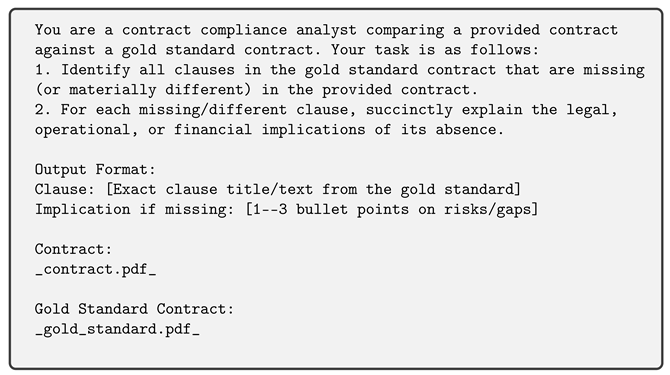 |
4.4. Enforceability
- The model evaluates each clause’s compliance with legal standards and assigns a confidence score (low, medium, high).
- Clauses with high confidence of non-compliance are flagged and reported to the user.
- Clauses with low/medium confidence undergo further scrutiny in subsequent stages.
- Rule 1: Always include the exact clause text in quotes after “Clause:”This ensures that the model’s analysis is anchored to the precise language of the contract, preventing misinterpretation or loss of context that could arise from paraphrasing.
- Rule 4: Never combine clauses - analyze each separatelySeparating clauses allows for clause-level risk and enforceability assessment, avoiding false positives or negatives that could result from aggregated or conflated language.
- Rule 6: Preserve all numbers and names exactly as writtenNumerical and named details often carry legal significance (e.g., deadlines, amounts, party identifiers). Preserving them ensures the model evaluates compliance accurately with respect to the intended contract specifications.
| Listing 2. Prompt to evaluate a contract with respect to regulations to determine compliance. |
 |
4.5. Riskiness
- 1.
- Risk Tier Assignment:
- High Risk: The clause clearly violates applicable law in commonly occurring scenarios.
- Medium Risk: The clause may raise enforceability concerns depending on the context, jurisdiction, or specific terms of enforcement.
- Low Risk: The clause is generally compliant and enforceable but may still require monitoring due to evolving interpretations or narrow exceptions.
- 2.
- Contextual Enforceability:Each clause is further classified as one of the following:
- Enforceable in [specific contexts]
- Unenforceable under [specific conditions]
- Lexical Ambiguity: Words allow multiple interpretations without sufficient context (e.g., “reasonable time”), leading to disputes over meaning [13].
- Syntactic Ambiguity: Unclear grammatical structure obscures obligations (e.g., “The contractor will repair the walls with cracks”) [14].
- Undue Generality: Provisions are overly broad or vague in scope (e.g., “must meet all necessary standards”), reducing precision and predictability [15].
- Redundancy: Restating obligations unnecessarily, which reduces drafting efficiency and risks internal inconsistency [13].
| Listing 3. Prompt to determine regulatory conformance of contract clauses. |
 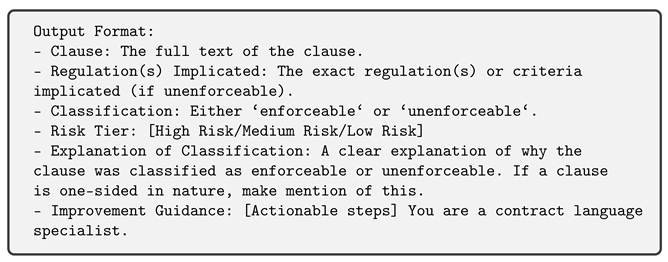 |
| Listing 4. Analyze contracts from a linguistic point of view. |
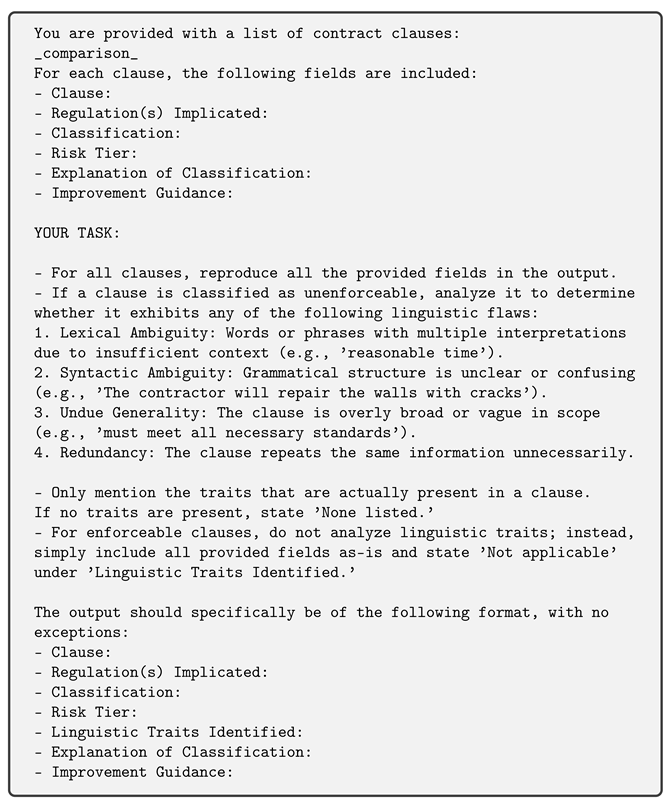 |
5. Experiments on Rental Contracts
5.1. Rental Agreements
5.1.1. Functionality Comparison
5.1.2. Automated Accuracy Evaluation
- Data Used: Using the keywords in the box below, we extracted 102 clauses from documented rental lawsuit cases in New York State available on Thomson Reuters WestLaw (https://signon.thomsonreuters.com/?productid=CBT&lr=0&culture=en-US&returnto=https%3a%2f%2f1.next.westlaw.com%2fCosi%2fSignOn&tracetoken=0514251349100j4DoQMa9n77sc_TtFHKFtoxdL2lf5mC6WbEDEbRTvUDeMiIF4-T4MoN9gsShPYAfygKn98JnpxOzCEndUOqRDFEM69ODsV7NIaRjeKgogmPjncySCp8PC27VSGx6iTi2aOsdA_OY5HsdxugLvQxGZ52DPBHs6r_SDLiJpUi_MHAyKUOqzn5vs8awNMVVxeD4DFWHDa-RTsBpE_2KPVvr_0FFHTmSapSD37XyNhTNgvK-ULJ7KAI_rCnn30pLg5EB2_yfoxAPKKYaJSNdsLdo28rE04T78jN1nySl6kLlKkD9Sll0JBfKqWtNEoxPZ00zi6oamOWzatGgR7MYg01RXgEKizCQ6dVtfZHz6ni6MV-TeuGU71YYS2S4KHNiVSqk&bhcp=1 (accessed on 1 November 2024)) in which the legal dispute focused on specific contractual terms. We did no further filtering. Each clause was labeled enforceable or unenforceable based on the court’s finding of enforceability.Here were the keywords used as the basis for the advanced search within WestLaw:landlord, tenant, indemnification clause,rental agreement, lease agreement
- Tool Inference: Each extracted clause was input into the respective tools under evaluation: Zero-Shot ContractNerd, goHeather, Legly, and YesChat.
- Performance Measurement: The outputs of the tools were compared against the ground truth (i.e., the court’s ruling) to compute standard classification metrics: accuracy, precision, recall, and F1 score.
5.1.3. Human Feedback Experiment
5.1.4. System Output Collection
5.1.5. Evaluation Framework
- Relevance—How directly the analysis addressed the content and intent of the clause.
- Accuracy—Whether the legal references and interpretations were factually and legally correct.
- Completeness—Whether the analysis covered all significant legal and contextual aspects.
- “System A seems to give a bit more information but assumes knowledge of legal terms. B explains implications of the various clauses and the output of A could be enhanced by incorporating this language.”
- “System A provides more detail and leaves me feeling more informed (especially under the explanation section). It also mentions the regulation that the clause is under and the classification, providing me with the opportunity to look it up for myself if I want to read about it in more depth. I find this informative.”
- “System B details how this clause may affect the tenant which provides more of a picture of what they would agree to should this clause be part of the tenancy agreement. Though this is not information that causes any legal risk, it is a ’nice-to-have’ and is not detailed by System A.”
- “The classification in System A makes the difference - it gives quick judgment without too much reading required. I do however appreciate the additional context given in B.”
- “If the user is a tenant, B offers a better explanation. Perhaps include a toggle to specify landlord/tenant user role”
5.1.6. Expert Qualitative Analysis
5.1.7. Other Jurisdictions
- Table A2, Appendix A shows the different ways in which New Jersey and California balance landlord rights to recover costs and tenant protections under lease cancellation scenarios. In both cases, ContractNerd classifies clauses governing the application of re-renting income toward landlord expenses and tenant debts as medium risk and enforceable, provided that expenses are reasonable and well-documented (see Table A2, Appendix A). However, California law explicitly requires landlords to mitigate damages by making reasonable efforts to re-rent and imposes stricter demands for documentation and expense limits, highlighting a stronger tenant protection framework compared with New Jersey’s approach. This suggests that, while both states protect landlord interests, California limits recoverable costs more rigorously.
- Another notable contrast concerns the warranty of habitability. In the case of New Jersey, a high risk classification was assigned to clauses that ambiguously limit the landlord’s obligation to provide essential services, deeming such provisions unenforceable if basic habitability standards are not met (Table A2, Appendix A). In contrast, California’s approach views similar clauses as low risk, recognizing that the warranty covers only fundamental residential fitness without guaranteeing additional amenities. This difference highlights California’s more permissive stance toward landlords’ limitations on service levels, whereas New Jersey seemingly prioritizes safeguarding tenant access to essential services under its Residential Landlord-Tenant Act.
6. Employment Agreements
- Divergence in Recovery of Employer Costs: The first clause—authorizing the employer to recover the cost of company-paid benefits upon employee resignation—illustrates a sharp jurisdictional contrast. In New Jersey, while the clause is broadly enforceable under the New Jersey Wage and Hour Law, its breadth creates a high risk of overreach, particularly when applied without proportionality or itemization. In California, the same clause risks violating strict statutory prohibitions on wage recoupment under Labor Code §221. This demonstrates how California adopts a more employee-centric approach, prioritizing wage integrity over contractual flexibility, whereas New Jersey permits broader enforcement provided statutory procedures are followed.
- Non-Compete and Restraint-of-Trade Clauses. The second clause, which functions as an in-term non-compete, can be enforceable in New Jersey under the New Jersey Trade Secrets Act if narrowly drafted. However, the language here is excessively broad—extending even to passive stock ownership—and is therefore vulnerable to legal challenge. In contrast, California law, through Business and Professions Code §16600, makes such restrictions almost entirely unenforceable unless a narrow statutory exception applies. This difference illustrates California’s near-total rejection of restraints on employee freedom, compared with New Jersey’s conditional acceptance based on reasonableness and legitimate business interests.
7. Limitations
- Partitioning: The document is segmented into smaller, overlapping chunks (e.g., 3–5 pages, or 10–15 clauses per chunk) to ensure that clause boundaries are preserved.
- Clause Extraction: Each chunk is independently analyzed by the language model to identify and classify clauses.
- Union of Results: The results from all chunks are combined into a unified set of clauses. Duplicate or overlapping clauses are merged.
- Completeness Tracking: Metadata (clause IDs, page/line numbers) is maintained during chunking so that all original clauses are accounted for in the final union.
- Post-Processing: The unified clause set is reconciled against the original document to ensure coverage, flagging any missing or unprocessed clauses for re-analysis if necessary.
- Employment contracts, especially as enforceable documents, are strongly anchored in the formal economy. Underground economy work is often carried out without any documentation and certainly no notion of legal enforcement. Therefore, the bias here is that this work is relevant only to those fortunate enough to be in the formal economy.
- Another source of bias is that our work is specific to the United States with an Anglo-Saxon style of laws based on precedents. Because we infer possible questionable clauses based on the analysis of laws, we believe, but haven’t proved, that similar methods could apply to countries which follow a rule-based legal system.
8. Conclusions
- Context-Aware Evaluation: ContractNerd grounds its analysis in specific regulations (e.g., NYS rental laws), reducing false positives in enforceability judgments.
- Structured Risk Framework: The tiered risk classification (High/Medium/Low) and contextual enforceability labels provide both an evaluation and suggestions for rewording, while linguistic trait analysis (lexical ambiguity, undue generality) further helps contract writers refine clause wording.
- User-Centric Design: Human evaluations resulted in a quite dramatic and statistically significance preference for ContractNerd’s outputs compared with the state of the art. This held particularly for ContractNerd’s regulatory citations and classification clarity.
Author Contributions
Funding
Institutional Review Board Statement
Data Availability Statement
Acknowledgments
Conflicts of Interest
Appendix A. Applying ContractNerd to Rental Agreement Other Jurisdictions
| Clause | New Jersey | California |
|---|---|---|
| “Pursuant to this provision, the tenant is to indemnify the landlord ‘for any damage flowing from such use’.” | Risk Tier:
Medium Risk Regulation(s): N.J.S.A. 2A:18-61.1 Classification: Enforceable in specific contexts (e.g., tenant’s use directly causes damage) Linguistic Traits: Not applicable Explanation: May relate to landlord’s right to recover damages under Anti-Eviction Act, but language requires clarification. Improvement: Rephrase to clarify scope: “The tenant shall indemnify the landlord for damages caused by the tenant’s negligence or willful misconduct.” | Risk Tier: Medium Risk Regulation(s): California Civil Code §§ 2782, 2782.5 Classification: Enforceable in specific contexts Linguistic Traits: Undue Generality Explanation: California law limits indemnity clauses in leases, especially if they require the tenant to indemnify the landlord for landlord’s own negligence. The phrase “any damage flowing from such use” is broad and ambiguous, potentially exposing the tenant to excessive liability. Improvement: Clarify and limit indemnity obligations to damages caused by tenant’s negligence or misconduct. Include clear carve-outs for landlord’s own negligence or willful misconduct. Use precise language defining “damage” and scope of indemnity. |
| “If Landlord breaches said agreement the parties hereby agree to use the American Arbitration Association to resolve their disputes and the prevailing party will be allowed to recover costs, expenses, and damages of said arbitration including but not limited to attorneys fees.” | Risk Tier: Medium Risk Regulation(s): N.J.S.A. 2A:18-61.1, N.J.S.A. 46:8-48 Classification: Enforceable where arbitration agreement is fair/reasonable Linguistic Traits: Not applicable Explanation: Subject to Anti-Eviction Act and Truth in Renting Act; fee recovery provisions may be regulated. Improvement: Clarify fairness: “Parties agree to AAA arbitration, each bearing own costs unless ruled otherwise.” | Risk Tier: Low Risk Regulation(s): California Arbitration Act (Cal. Code Civ. Proc. §§ 1280–1294.2) Classification: Enforceable Linguistic Traits: Not applicable Explanation: California generally enforces arbitration clauses and mutual attorney’s fees provisions unless unconscionable or violating public policy. Specifying the AAA and fee-shifting to the prevailing party aligns with California law and promotes efficient dispute resolution. Improvement: Specify procedures for initiation of arbitration, timelines, and confidentiality terms for completeness. Consider defining “prevailing party” to avoid disputes over fee recovery. |
| Clause | New Jersey | California |
|---|---|---|
| “If this Lease is canceled, or Landlord takes back the Apartment, the following takes place: … (3) Any rent received by Landlord for the re-renting shall be used first to pay Landlord’s expenses and second to pay any amounts Tenant owes under this Lease. Landlord’s expenses include the costs of getting possession and re-renting the Apartment, including, but not only reasonable legal fees, brokers fees, cleaning and repairing costs, decorating costs and advertising costs.” | Risk Tier:
Medium Risk Regulation(s): N.J.S.A. 2A:18-61.1, N.J.S.A. 46:8-48 Classification: Enforceable if expenses are reasonable/documentedif expenses are reasonable/documented Linguistic Traits: Not applicable Explanation: Procedures must comply with Anti-Eviction Act and Truth in Renting Act. Improvement: Specify, “Landlord shall apply re-renting income first to reasonable documented expenses, then tenant debtsProcedures must comply with Anti-Eviction Act and Truth in Renting Act. Improvement: Specify, ”Landlord shall apply re-renting income first to reasonable documented expenses, then tenant debts.” | Risk Tier: Medium Risk Regulation(s): California Civil Code §§ 1951.2, 1951.4 Classification: Enforceable under certain conditions Linguistic Traits: Not applicable Explanation: California requires landlords to mitigate damages by making reasonable efforts to re-rent. Prioritizing expenses before tenant obligations is common but must be reasonable and supported by documentation. Overly broad expense categories may invite disputes over what costs are recoverable. Improvement: Define “reasonable” more precisely or provide caps where possible. Require itemization of expenses to be charged against rent proceeds. |
| “The prong of the warranty of habitability implied in every residential lease by which the landlord covenants that the premises are fit for the uses reasonably intended by the parties does not encompass the level of services and amenities that tenants reasonably expect to be provided under the financial and other terms of their individual leases.” | Risk Tier: High Risk Regulation(s): N.J.S.A. 2A:42-84 Classification: Unenforceable if essential services are withheld Linguistic Traits: Undue Generality Explanation: Warranty of habitability under NJ Residential Landlord-Tenant Act requires essential services. Improvement: State explicitly, “Landlord shall provide [list essentials] per warranty of habitability requirements.” | Risk Tier: Low Risk Regulation(s): California Civil Code §§ 1941, 1941.1 Classification: Enforceable Linguistic Traits: Undue Generality Explanation: The warranty of habitability requires landlords to provide premises fit for basic residential use but does not guarantee amenities or service levels beyond those implied by law or explicitly stated in lease agreements. This clause correctly limits landlord obligations consistent with California law. Improvement: Consider specifying which services or amenities are excluded or included to avoid ambiguity. |
Appendix B. Expert Qualitative Analysis Continued
| Clause | System | Analysis | Comment |
|---|---|---|---|
| Late fee: Fixed Amount. $50 for each occurrence | ContractNerd (System A) |
| ContractNerd is easier to understand. The reference to New York law raises more issues than it resolves for the average reader. Both clauses are relevant and accurate. |
| GoHeather (System B) |
| ||
| Tenant waives the right to bring a declaratory judgment action with respect to any provision of this lease. | ContractNerd (System A) |
| ContractNerd is better, though I am not sure it is accurate to say that it is prohibited. Tenants cannot be forced to waive, but if they agree, the clause may be enforceable. |
| GoHeather (System B) |
| ||
| Tenant shall not assign the lease or sublet the premises without the landlord’s prior written consent | ContractNerd (System A) |
| Specifying the allowance for service animals avoids any issues about the subject. |
| GoHeather (System B) |
| ||
| Tenant must provide written notice of intent to vacate at least 60 days prior to lease termination. | ContractNerd (System A) |
| Leaving the time period blank signals to the tenant that this is a time period that can and should be bargained for to address the circumstances of the individual landlord and tenant. |
| GoHeather (System B) |
|
References
- RAGSys: Real-Time Self-Improvement for LLMs Without Retraining. Available online: https://www.reddit.com/r/MachineLearning/comments/1iyszck (accessed on 14 May 2025).
- DeepRAG: A Markov Decision Process Framework for Step-by-Step Retrieval-Augmented Reasoning. Available online: https://www.reddit.com/r/MachineLearning/comments/1iiyobh (accessed on 14 May 2025).
- Kim, J.; Min, M. From RAG to QA-RAG: Integrating Generative AI for Pharmaceutical Regulatory Compliance Process. arXiv 2024, arXiv:2402.01717. Available online: https://arxiv.org/abs/2402.01717 (accessed on 14 May 2025). [CrossRef]
- Yang, R. CaseGPT: A Case Reasoning Framework Based on Language Models and Retrieval-Augmented Generation. arXiv 2024, arXiv:2407.07913. Available online: https://arxiv.org/abs/2407.07913 (accessed on 14 May 2025).
- CoRAG: Chain-of-Retrieval Augmented Generation. Available online: https://www.reddit.com/r/machinelearningnews/comments/1ic9jst (accessed on 14 May 2025).
- VideoRAG: Enhancing Large Language Models with Dynamic Video Retrieval and Multimodal Knowledge Integration. Available online: https://www.reddit.com/r/ArtificialInteligence/comments/1i1xhhe (accessed on 14 May 2025).
- GoHeather. AI Contract Review App. GoHeather. 2025. Available online: https://www.goheather.io/products/ai-contract-review-app (accessed on 15 November 2024).
- YesChat. Contract Analysis. YesChat. 2025. Available online: https://www.yeschat.ai/gpts-9t557DQlTCC-Contract (accessed on 15 November 2024).
- Legly. AI-Powered Contract Analysis. Legly. 2025. Available online: https://www.legly.io (accessed on 15 November 2024).
- Gao, Y.; Gan, Y.; Chen, Y.; Chen, Y. Application of Large Language Models to Intelligently Analyze Long Construction Contract Texts. Constr. Manag. Econ. 2025, 43, 226–242. [Google Scholar] [CrossRef]
- Rengaraju, U. Automated Contract Analysis Using Snowflake-Arctic and Llama. Medium. Available online: https://usharengaraju.medium.com/automated-contract-analysis-using-snowflake-arctic-and-llama-17c0c7bd9a36 (accessed on 15 October 2024).
- New York State Lease Agreement. Available online: https://documents.dps.ny.gov/public/Common/ViewDoc.aspx?DocRefId=%7B1F7CE8C5-7408-425F-B513-58E94B6E6FDB%7D (accessed on 14 May 2025).
- Butt, P.; Castle, R. Modern Legal Drafting: A Guide to Using Clearer Language; Cambridge University Press: Cambridge, UK, 2006. [Google Scholar]
- Adams, K.A. A Manual of Style for Contract Drafting; American Bar Association: Chicago, IL, USA, 2004. [Google Scholar]
- Goetz, C.J.; Scott, R.E. Principles of Relational Contracts. Va. Law Rev. 1981, 67, 1089–1150. [Google Scholar] [CrossRef]
- Katari, M.S.; Tyagi, S.; Shasha, D. Synthesis Lectures on Mathematics and Statistics. In Statistics is Easy: Case Studies on Real Scientific Datasets; Morgan & Claypool Publishers: San Rafael, CA, USA, 2021. [Google Scholar]
- Barbierato, E.; Gatti, A.; Incremona, A.; Pozzi, A.; Toti, D. Breaking away from AI: The Ontological and Ethical Evolution of Machine Learning. IEEE Access 2025, 13, 55627–55647. [Google Scholar] [CrossRef]
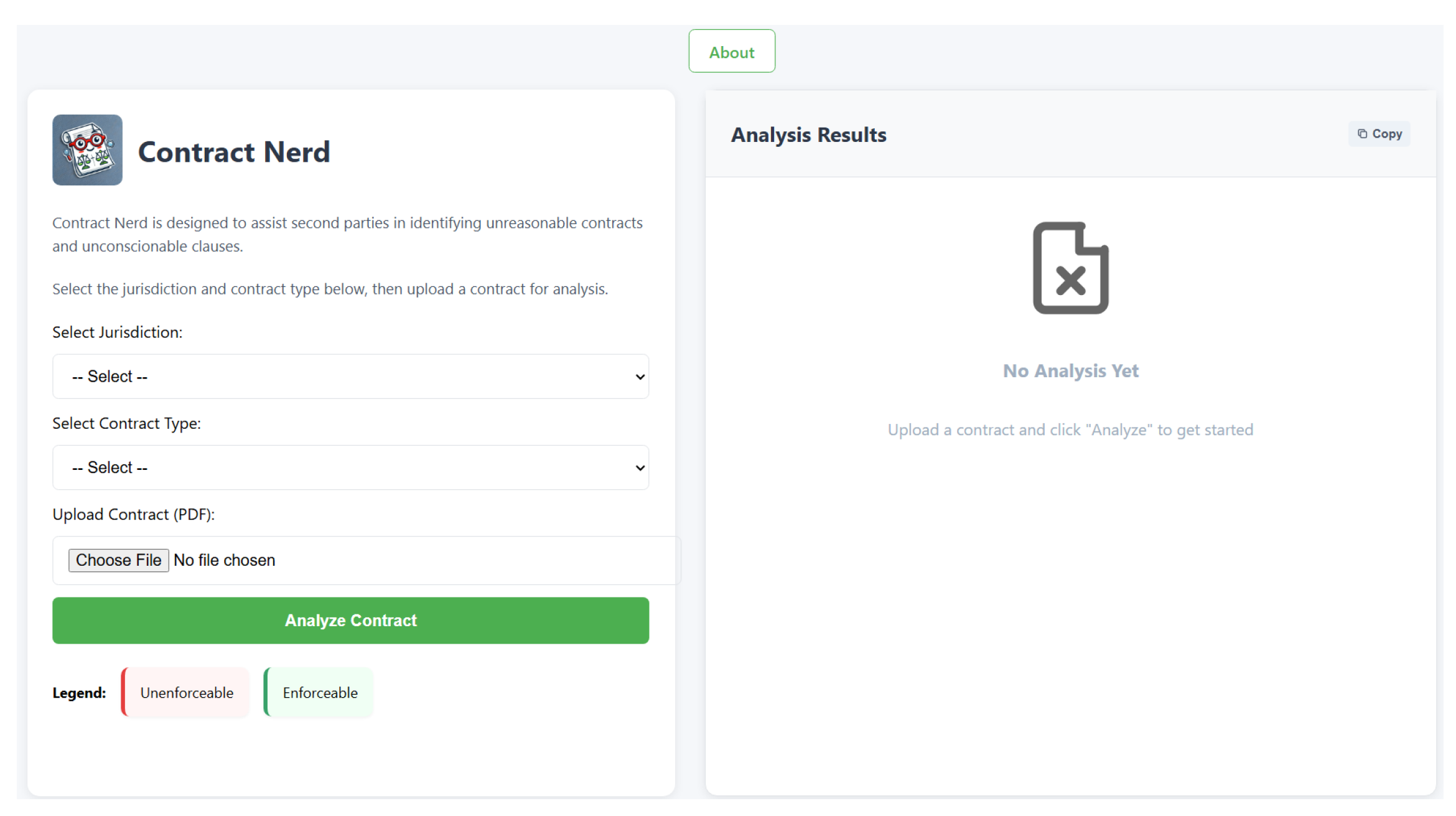
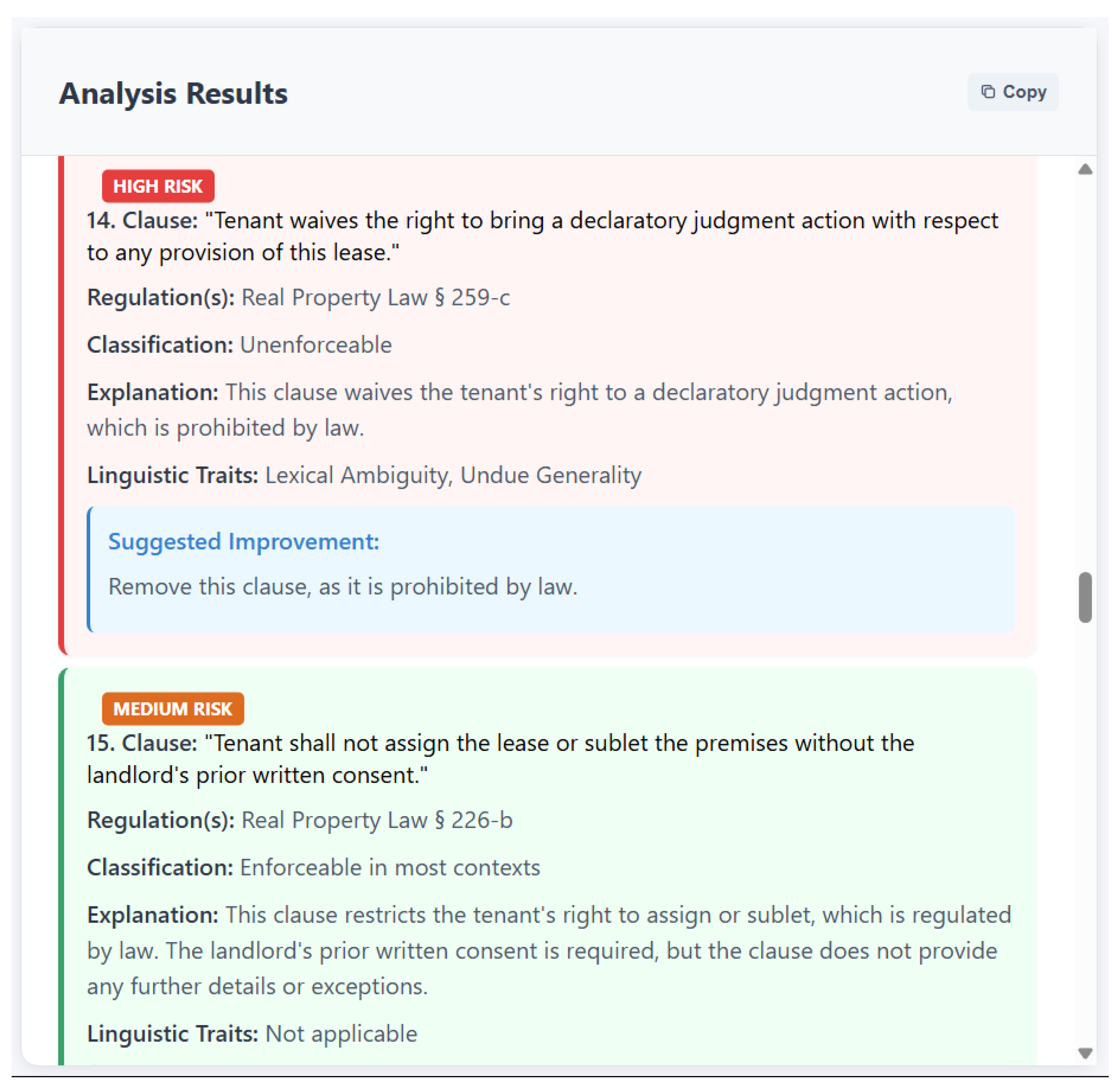
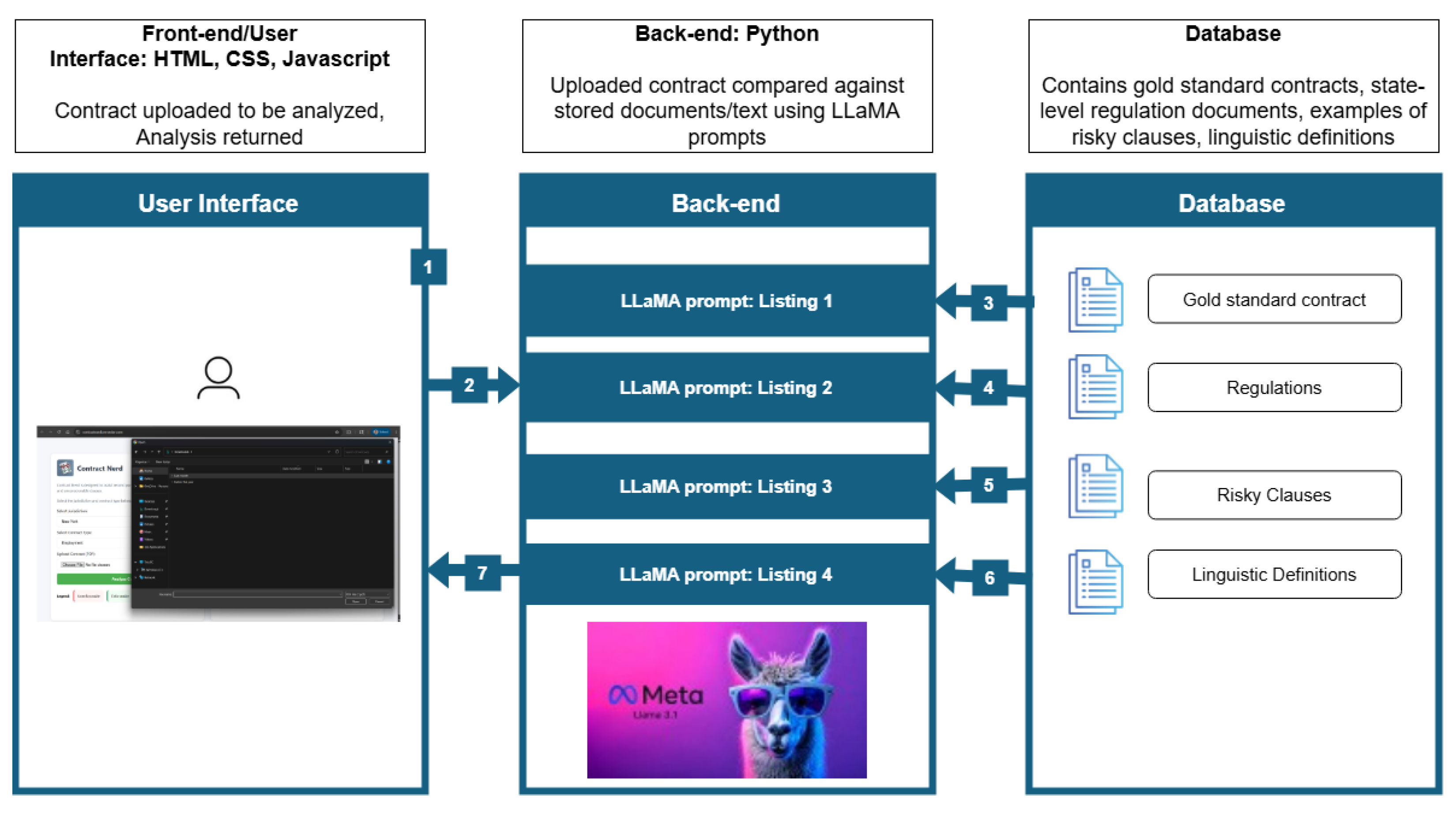
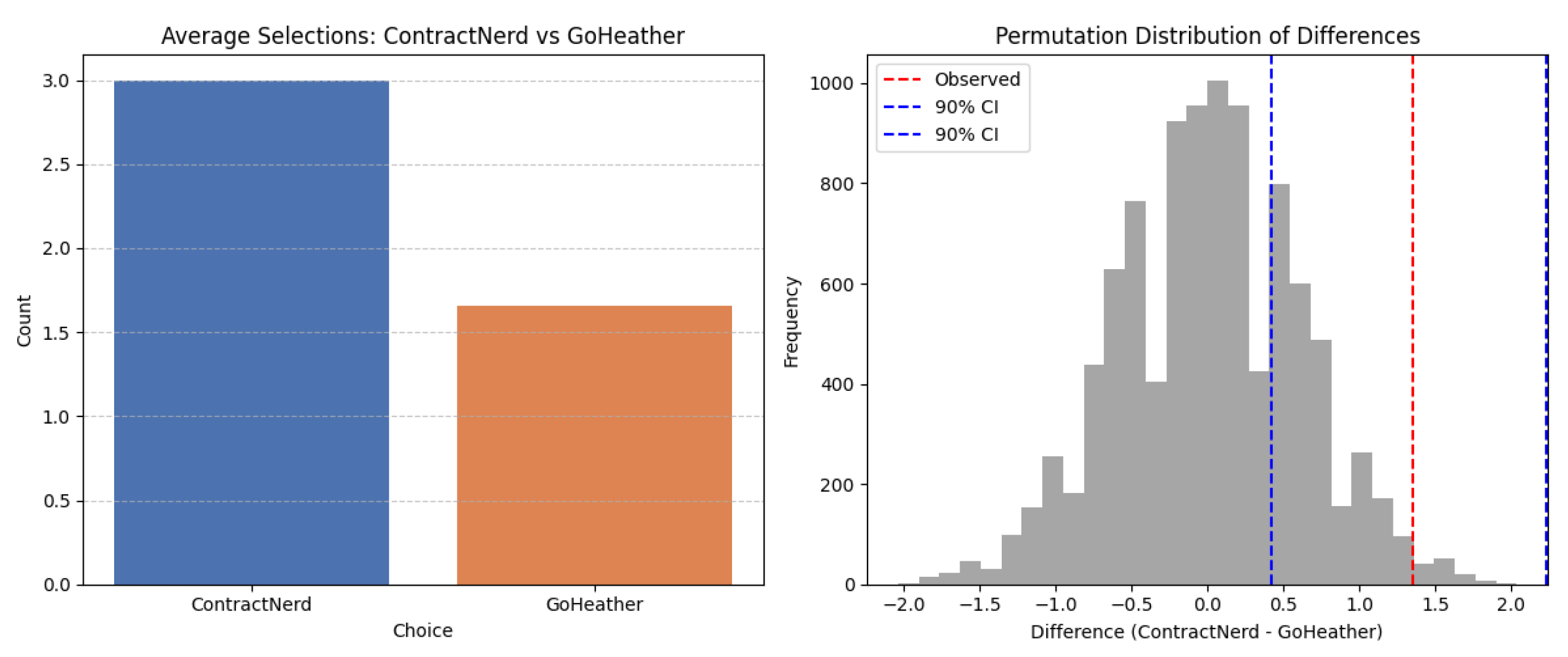
| Tool | Tool Analysis Summary |
|---|---|
| goHeather | Such a clause is likely unenforceable in most jurisdictions, as it violates basic employment rights and principles of personal freedom. |
| Legly | We found 0 clauses that you need to take a closer look at. |
| YesChat | This contains several problematic points that could potentially call into
question its enforceability: 1. Violation of the Right to Free Choice of Profession 2. Unreasonable Disadvantage 3. Immorality (Section 138 BGB) |
| ContractNerd | High Risk
Regulation(s):
Murphy v. American Home Products Corp., 58 N.Y.2d 293 (1983)
Classification: Unenforceable Explanation: This case highlights that New York is an “Employment-at-Will” state; this means that an employee may terminate his or her employment at any time. Suggested Improvement: Remove this clause, as it is prohibited by law. |
| Tool | Tool Analysis Summary |
|---|---|
| goHeather | Such a clause is likely unenforceable in most jurisdictions, as it violates basic employment rights and principles of personal freedom. |
| ContractNerd | High Risk Regulation(s): Real Property Law § 259-c Classification: Unenforceable Explanation: This clause waives the tenant’s right to a declaratory judgment action, which is prohibited by law. Suggested Improvement: Remove this clause, as it is prohibited by law. |
| System | Identify Missing Clauses | Give Reason for Unenforceability | Highlight Risky Clauses |
|---|---|---|---|
| GoHeather | ✓ | ✓ | |
| Legly | ✓ | ||
| ContractNerd | ✓ | ✓ | ✓ |
| YesChat | ✓ | ✓ |
| Tool | Accuracy (%) | Precision (%) | Recall (%) | F1 Score (%) |
|---|---|---|---|---|
| goHeather | 74.6 | 67.2 | 70.5 | 68.8 |
| 95% CI | (65.7, 82.4) | (41.9, 72.7) | (55.6, 87.1) | (49.3, 75.6) |
| p-value | <0.05 | 0.215 | 0.010 | 0.108 |
| Legly | 61.3 | 58.2 | 55.6 | 56.9 |
| 95% CI | (52.9, 70.6) | (40.0, 75.0) | (38.9, 73.5) | (41.3, 70.8) |
| p-value | <0.05 | 0.237 | 0.298 | 0.298 |
| YesChat | 53.9 | 52.1 | 49.8 | 50.9 |
| 95% CI | (45.1, 62.7) | (33.3, 69.2) | (32.3, 67.9) | (34.8, 64.7) |
| p-value | <0.05 | 0.500 | 0.570 | 0.570 |
| ContractNerd | 85.3 | 78.1 | 75.8 | 76.9 |
| 95% CI | (78.4, 92.2) | (62.5, 91.7) | (60.0, 90.0) | (64.2, 87.3) |
| p-value | <0.05 | <0.05 | <0.05 | <0.05 |
| Clause | System | Analysis | Comment |
|---|---|---|---|
| Tenant shall be liable for early termination fees as specified | ContractNerd (System A) |
| Reasonable termination fees may be difficult to know in advance, so requiring that they be detailed in the manner required by B could lead to incomplete specification. |
| GoHeather (System B) |
| ||
| Tenant shall not withhold rent for any reason without the landlord’s prior written consent. | ContractNerd (System A) |
| A will be confusing to the average tenant who does not know what the warranty of habitability or “law” provides. The “suggested change” in B does not change the initial language. |
| GoHeather (System B) |
| ||
| No pets allowed | ContractNerd (System A) |
| Specifying the allowance for service animals avoids any issues about the subject. |
| GoHeather (System B) |
| ||
| Tenant shall be responsible for all attorney fees incurred due to breach of this lease agreement | ContractNerd (System A) |
| B is shorter and easier to comprehend. |
| Tenant shall be responsible for all attorney fees incurred due to breach of this lease agreement | GoHeather (System B) |
|
| Clause | New Jersey | California |
|---|---|---|
| “In the event you terminate your employment with the Company by your resignation for any reason within eighteen (18) months of receiving a Company-paid benefit such as training, tuition reimbursement, seminars, compensation/performance based bonuses, relocation bonus/expenses, un-recovered advances against future salary, initial airfare, etc., the Company reserves the right to recover from you the full cost of such Company-paid benefit and to set off the cost of all or any portion of such Company-paid benefit against any amounts owed by the Company to you upon such termination of employment.” | Risk Tier:
High Risk Regulation(s): New Jersey Wage and Hour Law (NJWHL) Classification: Enforceable Linguistic Traits: Not applicable Explanation: This clause describes the repayment terms for company-paid benefits, which are subject to the NJWHL. The clause is one-sided in nature, as it only benefits the employer, inflicting significant financial obligations on the employee with no reciprocal requirement on the employer. Improvement: Limit covered benefits to a clearly defined list or “including but not limited to” with a defined scope; add pro-rata repayment; require itemized statement of costs; include “to the extent permitted by law” for any set-off; carve out repayment where resignation is due to company breach, constructive dismissal, or legal prohibition. | Risk Tier: High Risk Regulation(s): Cal Labor Code §221, Cal. Lab. Code § 2802 Classification: Enforceable Linguistic Traits: Undue Generality Explanation: Under California law, wage deductions are strictly regulated. Section 221 prohibits employers from recouping wages unless explicitly permitted by statute or a valid agreement. While recovery of certain expenses (e.g., training costs) may be enforceable if reasonable and tied to actual expenditures, the clause’s broad scope risks violating Section 221. Improvement: Specify exact repayment terms (e.g., prorated based on time remaining). Exclude wages from set-off and limit recovery to direct, documented costs. |
| “Employee agrees during the term of Employment not to engage in, work for, assist or be associated with in any way, or have any interest in, any business which competes with Itlize, or any business which solicits customers and markets similar products in those areas in which Itlize currently does business.” | Risk Tier: High Risk Regulation(s): New Jersey Trade Secrets Act (NJTSA) Classification: Enforceable Linguistic Traits: Undue Generality Explanation: The clause restricts the employee from being connected to any competing business in any form during employment. While in-term non-competes are generally enforceable in NJ, the scope here is overbroad (could include passive stock ownership) and vague in geographic reach. “Any interest in” could unintentionally capture harmless investments. Improvement: Narrow to competitive activities materially related to the employee’s role; exclude passive investments under a certain ownership percentage; define “competes” and “areas” with specificity; link restriction to protection of confidential information or legitimate business interests. | Risk Tier: High Risk Regulation(s): Cal. Bus. & Prof. Code § 16600 Classification: Unenforceable Linguistic Traits: Undue Generality Explanation: California’s Section 16600 voids non-compete agreements unless they fall under statutory exceptions (e.g., sale of a business). This clause’s blanket restriction on working for competitors or holding any interest in a competing business during employment is likely unenforceable, as it far exceeds the narrow bounds of permissible restraints. Courts routinely strike down such broad language as an unlawful restriction on lawful profession, trade, or business. Improvement: The clause should be narrowed to protect only legitimate business interests, such as trade secrets or confidential information. Remove phrases like “any interest in” and limit restrictions to direct competition or solicitation of specific clients. |
| “Employee hereby agrees that his/her employment with the Company may be terminated at any time and for any reason, or for no reason.” | Risk Tier: High Risk Regulation(s): New Jersey Law Against Discrimination (NJLAD) Classification: Enforceable Linguistic Traits: Not applicable Explanation: The clause accurately states NJ’s at-will employment doctrine but omits recognition of legal limits—employers cannot terminate for discriminatory, retaliatory, or otherwise unlawful reasons. The lack of such carve-outs can create risk of perceived overreach or employee. Improvement: Add explicit language that termination rights are “subject to applicable law” and cannot be for discriminatory, retaliatory, or otherwise unlawful reasons; clarify that at-will status can only be modified in writing by authorized representatives. | Risk Tier: Medium Risk Regulation(s): Cal. Lab. Code § 2922 Classification: Enforceable Linguistic Traits: Not applicable Explanation: California law presumes at-will employment under Section 2922, allowing termination without cause. However, exceptions exist (e.g., violations of public policy, implied contracts, or anti-discrimination laws). Improvement: Ensure no contradictory language exists elsewhere in the contract. Explicitly state that the at-will provision cannot be modified except in writing signed by an authorized Company representative. |
| “The Employee agrees that if the Employee terminates this Agreement prior to the Termination Date or Term Date, the Employee will pay Itlize a sum of One Thousand Dollars ($1000.00 ) for every month remaining on the Term Date or Termination Date, as a liquidated damages sum for the breach of this provision only, which is in addition to any other damages Itlize may seek for a breach of any other provision in this Agreement including but not limited to, the non-solicitation and non-competition provisions of this Agreement.” | Risk Tier: High Risk Regulation(s): New Jersey Law Against Discrimination (NJLAD) Classification: Enforceable Linguistic Traits: Not applicable Explanation: NJ courts will enforce liquidated damages only if they are a reasonable estimate of probable loss at the time of contracting—not a penalty. Here, $1000/month may be arbitrary and punitive, especially when combined with “in addition to any other damages.” Improvement: Tie damages to demonstrable costs incurred by the employer; remove “in addition to any other damages” or clarify that total recovery will not exceed actual losses; add carve-outs for termination due to employer breach or mutual agreement; ensure repayment mechanism complies with wage deduction laws. | Risk Tier: High Risk Regulation(s): Cal. Bus. & Prof. Code § 16600 Classification: Unenforceable Linguistic Traits: Undue Generality Explanation: Liquidated damages must reasonably estimate actual harm, not function as a penalty. Courts may view the monthly fee as punitive, especially if unrelated to demonstrable losses. Additionally, tying this provision to unenforceable non-compete terms (under Section 16600) further undermines its validity. Improvement: Remove references to non-compete clauses and recast liquidated damages as reimbursement for actual costs. Use a sliding scale (e.g., prorated repayment based on time worked) and provide a rationale for the amount |
Disclaimer/Publisher’s Note: The statements, opinions and data contained in all publications are solely those of the individual author(s) and contributor(s) and not of MDPI and/or the editor(s). MDPI and/or the editor(s) disclaim responsibility for any injury to people or property resulting from any ideas, methods, instructions or products referred to in the content. |
© 2025 by the authors. Licensee MDPI, Basel, Switzerland. This article is an open access article distributed under the terms and conditions of the Creative Commons Attribution (CC BY) license (https://creativecommons.org/licenses/by/4.0/).
Share and Cite
Sinkala, M.; Duan, Y.; Yuan, H.; Shasha, D. ContractNerd: An AI Tool to Find Unenforceable, Ambiguous, and Prejudicial Clauses in Contracts. Electronics 2025, 14, 4212. https://doi.org/10.3390/electronics14214212
Sinkala M, Duan Y, Yuan H, Shasha D. ContractNerd: An AI Tool to Find Unenforceable, Ambiguous, and Prejudicial Clauses in Contracts. Electronics. 2025; 14(21):4212. https://doi.org/10.3390/electronics14214212
Chicago/Turabian StyleSinkala, Musonda, Yuge Duan, Haowen Yuan, and Dennis Shasha. 2025. "ContractNerd: An AI Tool to Find Unenforceable, Ambiguous, and Prejudicial Clauses in Contracts" Electronics 14, no. 21: 4212. https://doi.org/10.3390/electronics14214212
APA StyleSinkala, M., Duan, Y., Yuan, H., & Shasha, D. (2025). ContractNerd: An AI Tool to Find Unenforceable, Ambiguous, and Prejudicial Clauses in Contracts. Electronics, 14(21), 4212. https://doi.org/10.3390/electronics14214212









